Geosites Inventory in Liguria Region (Northern Italy): A Tool for Regional Geoconservation and Environmental Management
Abstract
1. Introduction
2. Study Area
3. Materials and Methods
3.1. Recognition and Selection of Geosites
- Scientific interests: the selected geosites must be well distributed by primary and secondary scientific interests in order to represent the wide diversity of the geological and geomorphological features of the region. Geosites with multiple interests were privileged;
- Representativeness: the selected geosites must have good representativeness of a geological and/or geomorphological process;
- Geographical distribution: given the aforementioned criteria, an attempt was made to give a good geographical distribution of the chosen geosites in order to range throughout the entire regional territory without overrepresenting some areas and underrepresenting others.
3.2. Quantitative Assessment of Geosites
3.3. Degradation Risk Assessment of Geosites
4. Results
4.1. Recognition and Selection of Geosites
4.2. Quantitative Assessment of Geosites
4.3. Degradation Risk Assessment of Geosites
5. Discussion
6. Conclusions
Supplementary Materials
Author Contributions
Funding
Institutional Review Board Statement
Informed Consent Statement
Data Availability Statement
Acknowledgments
Conflicts of Interest
References
- Brocx, M.; Semeniuk, V. Geoheritage and geoconservation—History, definition, scope and scale. J. R. Soc. West. Aust. 2007, 90, 53–87. [Google Scholar]
- Burek, C.; Prosser, C. The history of geoconservation: An introduction. Geol. Soc. Lond. Spec. Publ. 2008, 300, 1–5. [Google Scholar] [CrossRef]
- Gray, M. Geodiversity: Valuing and Conserving Abiotic Nature, 2nd ed.; Wiley Blackwell: Chichester, UK, 2013. [Google Scholar]
- Reynard, E.; Brilha, J. Geoheritage: Assessment, Protection, and Management; Elsevier: Amsterdam, The Netherlands, 2018. [Google Scholar]
- Gray, M. Geodiversity: Valuing and Conserving Abiotic Nature, 1st ed.; Wiley, J., Ed.; The Atrium, Southern Gate: Chichester, UK, 2004. [Google Scholar]
- Gray, M. Geodiversity: The backbone of geoheritage and geoconservation. In Geoheritage: Assessment, Protection, and Management; Reynard, E., Brilha, J., Eds.; Elsevier: Amsterdam, The Netherlands, 2018; pp. 13–25. [Google Scholar]
- Newsome, D.; Dowling, R.K. Geotourism: The Tourism of Geology and Landscape; Goodfellow Publishers: Oxford, UK, 2010. [Google Scholar]
- Brilha, J. Inventory and quantitative assessment of geosites and geodiversity sites: A review. Geoheritage 2016, 8, 119–134. [Google Scholar] [CrossRef]
- Van den Ancker, H.J.A.M.; Jungerius, P.D. Geodiversity, geoheritage and geoconservation along the Dutch coast. Ned. Geogr. Stud. 2004, 325, 63–72. [Google Scholar]
- Brock, M.; Semeniuk, V. Coastal geoheritage: Encompassing physical, chemical and biological processes, landforms, and other geological features in the coastal zone. J. R. Soc. West. Aust. 2009, 92, 243–260. [Google Scholar]
- Brock, M.; Semeniuk, V. Coastal geoheritage: A hierarchical approach to classifying coastal types as a basis for identifying geodiversity and sites of significance in Western Australia. J. R. Soc. West Aust. 2010, 93, 81–113. [Google Scholar]
- Cappadonia, C.; Coratza, P.; Agnesi, V.; Soldati, M. Malta and Sicily joined by geoheritage enhancement and geotourism within the framework of land management and development. Geosciences 2018, 8, 253. [Google Scholar] [CrossRef]
- Coratza, P.; Vandelli, V.; Fiorentini, L.; Paliaga, G.; Faccini, F. Bridging terrestrial and marine geoheritage: Assessing geosites in Portofino Natural Park (Italy). Water 2019, 11, 2112. [Google Scholar] [CrossRef]
- Margiotta, S.; Parise, M. Hydraulic and geomorphological hazards at wetland geosites along the eastern coast of Salento (SE Italy). Geoheritage 2019, 11, 1655–1666. [Google Scholar] [CrossRef]
- Selmi, L.; Coratza, P.; Gauci, R.; Soldati, M. Geoheritage as a tool for environmental management: A case study in Northern Malta (Central Mediterranean Sea). Resources 2019, 8, 168. [Google Scholar] [CrossRef]
- Garavaglia, V.; Pelfini, M.; Bollati, I. The influence of climate change on glacier geomorphosites: The case of two Italian glaciers (Miage Glacier, Forni Glacier) investigated through dendrochronology. Géomorphologie 2010, 2, 153–164. [Google Scholar] [CrossRef]
- Bosson, J.B.; Reynard, E. Geomorphological heritage, conservation and promotion in high-alpine protected areas. Eco. Mont 2012, 4, 13–22. [Google Scholar] [CrossRef][Green Version]
- Reynard, E.; Coratza, P. The importance of mountain geomorphosites for environmental education. Examples from the Italian Dolomites and the Swiss Alps. Acta Geogr. Slov. 2016, 56, 291–303. [Google Scholar] [CrossRef]
- Hoblea, F.; Delannoy, J.J.; Jaillet, S.; Ployon, E.; Sadier, B. Digital Tools for Managing and Promoting Karst Geosites in Southeast France. Geoheritage 2014, 6, 113–127. [Google Scholar] [CrossRef]
- Ballesteros, D.; Fernández-Martínez, E.; Carcavilla, L.; Jiménez-Sánchez, M. Karst cave geoheritage in protected areas: Characterisation and proposals of management of deep caves in the Picos de Europa National Park (Spain). Geoheritage 2019, 11, 1919–1939. [Google Scholar] [CrossRef]
- Antić, A.; Tomić, N.; Marković, S. Karst geoheritage and geotourism potential in the Pek River lower basin (Eastern Serbia). Geogr. Pann. 2019, 23, 32–46. [Google Scholar] [CrossRef]
- Liso, I.S.; Chieco, M.; Fiore, A.; Pisano, L.; Parise, M. Underground geosites and caving speleotourism: Some considerations, from a case study in Southern Italy. Geoheritage 2020, 12, 13. [Google Scholar] [CrossRef]
- Ávila, S.P.; Cachão, M.; Ramalho, R.S.; Botelho, A.Z.; Madeira, P.; Rebelo, A.C.; Cordeiro, R.; Melo, C.; Hipólito, A.; Ventura, M.A.; et al. The Palaeontological Heritage of Santa Maria Island (Azores: NE Atlantic): A Re-evaluation of Geosites in GeoPark Azores and Their Use in Geotourism. Geoheritage 2016, 8, 155–171. [Google Scholar] [CrossRef]
- Migoń, P.; Pijet-Migoń, E. Overlooked geomorphological component of volcanic geoheritage—Diversity and perspectives for tourism industry, Pogórze Kaczawskie region, SW Poland. Geoheritage 2016, 8, 333–350. [Google Scholar] [CrossRef]
- Nemeth, K.; Moufti, M.R. Geoheritage Values of a Mature Monogenetic Volcanic Field in Intra-continental Settings: Harrat Khaybar, Kingdom of Saudi Arabia. Geoheritage 2017, 9, 311–328. [Google Scholar] [CrossRef]
- Różycka, M.; Migoń, P. Customer-Oriented Evaluation of Geoheritage—on the Example of Volcanic Geosites in the West Sudetes, SW Poland. Geoheritage 2018, 10, 23–37. [Google Scholar] [CrossRef]
- Pica, A.; Vergari, F.; Fredi, P.; Del Monte, M. The Aeterna Urbs geomorphological heritage (Rome, Italy). Geoheritage 2016, 8, 31–42. [Google Scholar] [CrossRef]
- Erikstad, L.; Nakrem, H.A.; Markussen, J.A. Protected geosites in an urban area of Norway, inventories, values and management. Geoheritage 2018, 10, 219–229. [Google Scholar] [CrossRef]
- Sacchini, A.; Ponaro, M.I.; Paliaga, G.; Piana, P.; Faccini, F.; Coratza, P. Geological landscape and stone heritage of the Genoa walls Urban park and surrounding area (Italy). J. Maps 2018, 14, 528–541. [Google Scholar] [CrossRef]
- Cimmino, F.; Faccini, F.; Robbiano, A. Stones and coloured marbles of Liguria in historical monuments. Per. Miner. 2004, 73, 71–84. [Google Scholar]
- Melelli, L.; Bizzarri, R.; Baldanza, A.; Gregori, L. The etruscan “Volumni Hypogeum” archeo-geosite: New sedimentological and geomorphological insights on the tombal complex. Geoheritage 2016, 8, 301–314. [Google Scholar] [CrossRef]
- Fidelibus, M.D.; Pellicani, R.; Argentiero, I.; Spilotro, G. The geoheritage of the water intake of Triglio ancient aqueduct (Apulia region, Southern Italy): A lesson of advanced technology insensitive to climate changes from an ancient geosite. Geoheritage 2018, 10, 327–339. [Google Scholar] [CrossRef]
- Sardella, R.; Iurino, A.D.; Mecozzi, B.; Sigari, D.; Bona, F.; Bellucci, L.; Coltorti, M.; Conti, J.; Lembo, G.; Muttillo, B.; et al. Grotta Romanelli (Lecce, Southern Italy) between past and future: New studies and perspectives for an archaeo-geosite symbol of the Palaeolithic in Europe. Geoheritage 2019, 11, 1413–1432. [Google Scholar] [CrossRef]
- Brzezińska-Wójcik, T.; Skowronek, E. Tangible Heritage of the Historical Stonework Centre in Brusno Stare in the Roztocze Area (SE Poland) as an Opportunity for the Development of Geotourism. Geoheritage 2020, 12, 10. [Google Scholar] [CrossRef]
- Geremia, F.; Bentivenga, M.; Palladino, G. Environmental geology applied to geoconservation in the interaction between geosites and linear infrastructures in South-Eastern Italy. Geoheritage 2015, 7, 33–46. [Google Scholar]
- Fuertes-Gutiérrez, I.; García-Ortiz, E.; Fernández-Martínez, E. Anthropic Threats to Geological Heritage: Characterization and Management: A Case Study in the Dinosaur Tracksites of La Rioja (Spain). Geoheritage 2016, 8, 135–153. [Google Scholar] [CrossRef]
- Reynard, E.; Coratza, P.; Regolini-Bissig, G. Geomorphosites; Verlag Dr. Friedrich Pfeil: Munich, Germany, 2009. [Google Scholar]
- Brilha, J. Geoheritage: Inventories and evaluation. In Geoheritage: Assessment, Protection and Management; Reynard, E., Brilha, J., Eds.; Elsevier: Amsterdam, The Netherlands, 2018; pp. 69–86. [Google Scholar]
- The United Nations Educational, Scientific and Cultural Organization (UNESCO). Geoparks Programme: A new initiative to promote a global network of geoparks safeguarding and developing selected areas having significant geological features. In Proceedings of the 156th UNESCO Executive Board, Paris, France, 4 March 1999. [Google Scholar]
- Amorfini, A.; Bartelletti, A.; Ottria, G. Enhancing the Geological Heritage of the Apuan Alps Geopark (Italy). In From Geoheritage to Geoparks. Geoheritage, Geoparks and Geotourism (Conservation and Management Series); Errami, E., Brocx, M., Semeniuk, V., Eds.; Springer: Cham, Switzerland, 2015. [Google Scholar]
- Lima, E.A.; Machado, M.; Guerreiro, M.; Nunes, J.; Costa, M.P. Geological heritage management in small islands: The example of the Azores UNESCO Global Geopark (Portugal). Geoheritage 2018, 10, 659–671. [Google Scholar] [CrossRef]
- Sá, A.A.; Rocha, D. Arouca UNESCO Global Geopark: Geomorphological Diversity Fosters Local Development. In Landscapes and Landforms of Portugal. World Geomorphological Landscapes; Vieira, G., Zêzere, J., Mora, C., Eds.; Springer: Cham, Switzerland, 2020. [Google Scholar]
- Sinnyovsky, D.; Sachkov, D.; Tsvetkova, I.; Atanasova, N. Geomorphosite characterization method for the purpose of an aspiring geopark application dossier on the example of Maritsa Cirque Complex in Geopark Rila, Rila Mountain, SW Bulgaria. Geoheritage 2020, 12, 26. [Google Scholar] [CrossRef]
- Vieira, G.; de Castro, E.; Gomes, H.; Loureiro, F.; Fernandes, M.; Patrocínio, F.; Firmino, G.; Forte, J. The Estrela Geopark—From Planation Surfaces to Glacial Erosion. In Landscapes and Landforms of Portugal. World Geomorphological Landscapes; Vieira, G., Zêzere, J., Mora, C., Eds.; Springer: Cham, Switzerland, 2020. [Google Scholar]
- Brancucci, G.; Gisotti, G.; Zarlenga, F. Italy. In Geoheritage in Europe and its Conservation; Wimbledon, W.A.P., Smith-Meyer, S., Eds.; ProGEO: Oslo, Norway, 2012; pp. 188–199. [Google Scholar]
- Giovagnoli, M.C. Geoheritage in Italy. In Landforms and Landforms of Italy. World Geomorphological Landscapes; Soldati, M., Marchetti, M., Eds.; Springer: Cham, Switzerland, 2017. [Google Scholar]
- Italian UNESCO Global Geoparks. Available online: http://www.unesco.org/new/en/natural-sciences/environment/earth-sciences/unesco-global-geoparks/list-of-unesco-global-geoparks/italy (accessed on 21 February 2021).
- Inventario Nazionale dei Geositi. Available online: http://sgi2.isprambiente.it/geositiweb/ (accessed on 16 January 2021).
- Brancucci, G.; Grillo, R.; Menozzi, B.; Paliaga, G. Censimento dei geomorfositi nella provincia di Savona. In Geositi e Dintorni; Brancucci, G., Ed.; Colombo Grafiche: Genova, Italy, 2004; pp. 17–99. [Google Scholar]
- Burlando, M.; Firpo, M.; Queirolo, C.; Rovere, A.; Vacchi, M. From geoheritage to sustainable development: Strategies and perspectives in the Beigua Geopark (Italy). Geoheritage 2011, 3, 63–72. [Google Scholar] [CrossRef]
- Poggi, E.; Queirolo, C.; Burlando, M.; Poggi, F. Geosites inventory in the Liguria Region (Italy) and in Beigua Geopark: Updating activities. Rend. Online Soc. Geol. Ital. 2013, 28, 121–124. [Google Scholar]
- Köppen, W. Das geographische System der Klimate. In Handbuch der Klimatologie; Köppen, W., Geiger, R., Eds.; Borntraeger: Berlin, Germany, 1936. [Google Scholar]
- Fratianni, S.; Acquaotta, F. The Climate of Italy. In Landscapes and Landforms of Italy. World Geomorphological Landscapes; Soldati, M., Marchetti, M., Eds.; Springer: Cham, Switzerland, 2017. [Google Scholar]
- Capponi, G.; Crispini, L.; Federico, L.; Malatesta, C. Geology of the Eastern Ligurian Alps: A review of the tectonic units. Ital. J. Geosci. 2016, 135, 157–169. [Google Scholar] [CrossRef]
- Giammarino, S.; Capponi, G.; Crispini, L.; Giglia, G.; Piazza, M. Carta Geologica della Liguria—Scala 1:200.000; LAC: Firenze, Italy, 2002. [Google Scholar]
- Mosca, P.; Polino, R.; Rogledi, S.; Rossi, M. New data for the kinematic interpretation of the Alps-Apennines junction (Northwestern Italy). Int. J. Earth Sci. (Geol. Rundsch.) 2009, 99, 833–849. [Google Scholar] [CrossRef]
- Molli, G.; Crispini, L.; Malusà, M.; Mosca, P.; Piana, F.; Federico, L. Geology of the Western Alps-Northern Apennine junction area: A regional review. J. Virtual Explor. 2010, 36, 1–49. [Google Scholar] [CrossRef]
- Fanucci, F.; Nosengo, S. Rapporti fra neotettonica e fenomeni morfogenetici del versante marittimo dell’Appennino Ligure e del margine continentale. Boll. Soc. Geol. It. 1977, 96, 41–51. [Google Scholar]
- Progetto IFFI (Inventario dei Fenomeni Franosi in Italia) [Inventory of Landslide Phenomena in Italy]. Available online: https://www.isprambiente.gov.it/it/progetti/cartella-progetti-in-corso/suolo-e-territorio-1/iffi-inventario-dei-fenomeni-franosi-in-italia (accessed on 17 January 2021).
- Faccini, F.; Federico, L.; Torchio, S.; Roccati, A.; Capponi, G.; Crispini, L. A mountain slope deformation in an alpine metaophiolitic massif (Ligurian Alps, Italy). J. Maps 2020. [Google Scholar] [CrossRef]
- Faccini, F.; Benedettini, A.; Firpo, M.; Perasso, L.; Poggi, F. Land-management and planning in karst areas: The ligurian case-study (Italy). Rend. Online Soc. Geol. It. 2012, 21, 611–613. [Google Scholar]
- Firpo, M.; Guglielmin, M.; Queirolo, C. Relict blockfields in the Ligurian Alps (Mount Beigua, Italy). Permafr. Periglac. Process. 2006, 17, 71–78. [Google Scholar] [CrossRef]
- Cattaneo Vietti, R.; Albertelli, G.; Aliani, S.; Bava, S.; Bavestrello, G.; Benedetti Cecchi, L.; Bianchi, C.N.; Bozzo, E.; Capello, M.; Castellano, M.; et al. The Ligurian Sea: Present status, problems and perspectives. Chem. Ecol. 2010, 26, 319–340. [Google Scholar] [CrossRef]
- Mastronuzzi, G.; Aringoli, D.; Aucelli, P.; Baldassarre, A.; Bellotti, P.; Bini, M.; Biolchi, S.; Bontempi, S.; Brandolini, P.; Chelli, A.; et al. Geomorphological map of the Italian coast: From a descriptive to a morphodynamic approach. Geogr. Fis. Dinam. Quat. 2017, 40, 161–195. [Google Scholar]
- Brandolini, P.; Cappadonia, C.; Luberti, G.M.; Donadio, C.; Stamatopoulos, L.; Di Maggio, C.; Faccini, F.; Stanislao, C.; Vergari, F.; Paliaga, G.; et al. Geomorphology of the Anthropocene in Mediterranean urban areas. Prog. Phys. Geogr. 2019, 44, 461–494. [Google Scholar] [CrossRef]
- Paliaga, G.; Luino, F.; Turconi, L.; De Graff, J.V.; Faccini, F. Terraced landscapes on Portofino Promontory (Italy): Identification, geo-hydrological hazards and management. Water 2020, 12, 435. [Google Scholar] [CrossRef]
- Fuertes-Gutiérrez, I.; Fernández-Martínez, E. Geosites Inventory in the Leon province (Northwestern Spain): A tool to introduce Geoheritage into Regional Environmental Management. Geoheritage 2010, 2, 57–75. [Google Scholar] [CrossRef]
- Del Monte, M.; Fredi, P.; Pica, A.; Vergari, F. Geosites within Rome city center (Italy): A mixture of cultural and geomorphological heritage. Geogr. Fis. Dinam. Quat. 2013, 36, 241–257. [Google Scholar]
- Garcia, M.d.G.; Del Lama, E.; Martins, L.; Mazoca, C.E.M.; Bourotte, C.L.M. Inventory and assessment of geosites to stimulate regional sustainable management: The northern coast of the state of São Paulo, Brazil. Acad. Bras. Ciênc. 2019, 91. [Google Scholar] [CrossRef] [PubMed]
- Bruschi, V.M.; Cendrero, A. Geosite evaluation: Can we measure intangible values? Ital. J. Quat. Sci. 2005, 18, 293–306. [Google Scholar]
- Coratza, P.; Giusti, C. Methodological proposal for the assessment of the scientific quality of geomorphosites. Ital. J. Quat. Sci. 2005, 18, 303–313. [Google Scholar]
- Pralong, J.-P.; Reynard, E. A proposal for a geomorphological sites classification depending on their tourist value. Il Quat. 2005, 18, 313–319. [Google Scholar]
- Zouros, N. Geomorphosite assessment and management in protected areas of Greece. Case study of the Lesvos Island-coastal geomorphosites. Geogr. Helv. 2007, 62, 69–180. [Google Scholar] [CrossRef]
- Pereira, P.; Pereira, D.; Caetano Alves, M.I. Geomorphosite assessment in Montesinho Natural Park (Portugal). Geogr. Helv. 2007, 62, 159–168. [Google Scholar] [CrossRef]
- Rybár, P. Assessment of attractiveness (value) of geotouristic objects. Acta Geoturistica 2010, 1, 13–21. [Google Scholar]
- Vujicic, M.D.; Vasiljevic, D.E.; Markovic, S.B.; Hose, T.A.; Lukic, T.; Hadzic, O.; Janicevic, S. Slankamen villages preliminary geosite assessment model (GAM) and its application on Fruska Gora Mountain, potential geotourism destination of Serbia. Acta Geogr. Slov. 2011, 51, 361–377. [Google Scholar] [CrossRef]
- Fassoulas, C.; Mouriki, D.; Dimitriou-Nikolakis, P.; Iliopoulos, G. Quantitative assessment of geotopes as an effective tool for geoheritage management. Geoheritage 2012, 4, 177–193. [Google Scholar] [CrossRef]
- Kubalíková, L. Geomorphosite assessment for geotourism purposes. Czech. J. Tour. 2013, 2, 80–104. [Google Scholar] [CrossRef]
- Štrba, L.; Rybár, P.; Baláž, B.; Molokáč, M.; Hvizdák, L.; Kršák, B.; Lukáč, M.; Muchová, L.; Tometzová, D.; Ferenčíková, J. Geosite assessments: Comparison of methods and results. Curr. Issues Tour. 2015, 18, 496–510. [Google Scholar] [CrossRef]
- De Wever, P.; Alterio, I.; Egoroff, G.; Cornée, A.; Bobrowsky, P.; Collin, G.; Duranthon, F.; Hill, W.; Lalanne, A.; Page, K. Geoheritage, a National Inventory in France. Geoheritage 2015, 7, 205–247. [Google Scholar] [CrossRef]
- Szepesi, J.; Ésik, Z.; Soós, I.; Németh, B.; Sütő, L.; Novák, T.J.; Harangi, S.; Lukáks, R. Identification of Geoheritage Elements in a Cultural Landscape: A Case Study from Tokaj Mts, Hungary. Geoheritage 2020, 12, 89. [Google Scholar] [CrossRef]
- Brancucci, G.; Paliaga, G. Atlante dei Geositi della Liguria; Grafiche Amadeo: Imperia, Italy, 2008. [Google Scholar]
- Faccini, F.; Gabellieri, N.; Paliaga, G.; Piana, P.; Angelini, S.; Coratza, P. Geoheritage map of the Portofino Natural Park (Italy). J. Maps 2018, 14, 87–96. [Google Scholar] [CrossRef]
- Reynard, E.; Fontana, G.; Kozlik, L.; Scapozza, C. A method for assessing scientific and additional values of geomorphosites. Geogr. Helv. 2007, 62, 148–158. [Google Scholar] [CrossRef]
- Reynard, E.; Perret, A.; Bussard, J.; Grangier, L.; Martin, S. Integrated approach for the inventory and management of geomorphological heritage at the regional scale. Geoheritage 2016, 8, 43–60. [Google Scholar] [CrossRef]
- Kirillova, K.; Fu, X.; Lehto, X.; Cai, L. What makes a destination beautiful? Dimension of tourist aesthetic judgement. Tour. Manag. 2014, 42, 282–293. [Google Scholar] [CrossRef]
- Ruban, D.A.; Sallam, E.S.; Ermolaev, V.A.; Yashalova, N.N. Aesthetic value of colluvial blocks in geosite-based tourist destinations: Evidence from SW Russia. Geosciences 2020, 10, 51. [Google Scholar] [CrossRef]
- Miljković, D.; Božić, S.; Miljković, L.; Marković, S.B.; Lukić, T.; Jovanović, M.; Bjelajac, D.; Vasiljević, D.A.; Vujičić, M.D.; Ristanović, B. Geosite assessment using three different methods; a comparative study of the Krupaja and the Zagubica Springs—Hydrological heritage of Serbia. Open Geosci. 2018, 10, 192–208. [Google Scholar] [CrossRef]
- Coratza, P.; Galve, J.P.; Soldati, M.; Tonelli, C. Recognition and assessment of sinkholes as geosites: Lessons from the Island of Gozo (Malta). Quaest. Geogr. 2012, 31, 25–35. [Google Scholar] [CrossRef]
- Carcavilla, L.; López Martínez, J.; Durán Valsero, J.J. Patrimonio geológico y geodiversidad: Investigación, conservación, gestión y relación con los espacios naturales protegidos; Cuadernos del Museo Geominero: Madrid, Spain, 2007. [Google Scholar]
- Cendrero, A. El patrimonio geológico. Ideas para su protección, conservación y utilización. In El patrimonio Geológico. Bases para su Valoración, Protección, Conservación y Utilización, Serie Monografías del Ministerio de Obras Públicas, Transportes y Medio Ambiente; Ministerio de Obras Públicas. Transportes y Medio Ambiente: Madrid, Spain, 1996; pp. 17–27. [Google Scholar]
- Cendrero, A. Propuestas sobre criterios para la clasificación y catalogación del patrimonio geológico. In El Patrimonio Geológico. Bases para su Valoración, Protección, Conservación y Utilización; Serie Monografías del Ministerio de Obras Públicas, Transportes y Medio Ambiente; Ministerio de Obras Públicas, Transportes y Medio Ambiente: Madrid, Spain, 1996; pp. 29–38. [Google Scholar]
- Fuertes-Gutiérrez, I.; Fernández-Martínez, E. Mapping geosites for geoheritage management: A methodological proposal for the Regional Park of Picos de Europa (León, Spain). Environ. Manag. 2012, 50, 789–806. [Google Scholar] [CrossRef] [PubMed]
- Marchetti, M.; Coratza, P.; Carton, A. Guidelines for geomorphological sites mapping: Examples from Italy. Géomorpholohie Relief Process. Environ. 2005, 3, 209–218. [Google Scholar]
- Coratza, P.; Regolini-Bissig, G. Methods for mapping geomorphosites. In Geomorphosites; Reynard, E., Coratza, P., Regolini-Bissig, G., Eds.; Verlag Dr. Friedrich Pfeil: Munich, Germany, 2009. [Google Scholar]
- Dinelli, E.; Lucchini, F.; Fabbri, M.; Cortecci, G. Metal distribution and environmental problems related to sulphide oxidation in the Libiola copper mine area (Ligurian Apennines, Italy). J. Geochem. Explor. 2001, 74, 141–152. [Google Scholar] [CrossRef]
- Marescotti, P.; Carbone, C.; Comodi, P.; Frondini, F.; Lucchetti, G. Mineralogical and chemical evolution of ochreous precipitates from the Libiola Fe–Cu-sulfide mine (Eastern Liguria, Italy). Appl. Geochem. 2012, 27, 577–589. [Google Scholar] [CrossRef]
- Cucchi, F.; Finocchiaro, F.; Muscio, G. Gesositi del Friuli Venezia Giulia. Dipartimento di Scienze Geologiche, Ambientali e Marine dell’Università degli Studi di Trieste e dal Museo Friulano di Storia Naturale di Udine. Available online: https://www.regione.fvg.it/rafvg/cms/RAFVG/ambiente-territorio/tutela-ambiente-gestione-risorse-naturali/FOGLIA201/FOGLIA16/ (accessed on 21 February 2021).
- Cazzoli, M.A.; Centineo, M.C.; Daniele, G. Censimento, Tutela e Valorizzazione del Patrimonio Geologico Regionale. I Geositi dell’Emilia-Romagna—Rivista Storie Naturali. 29–33. Available online: https://ambiente.regione.emilia-romagna.it/it/geologia/geologia/geositi-paesaggio-geologico/pdf/i_geositi_dell_Emiliaromagna.pdf (accessed on 21 February 2021).
- Mastronuzzi, G.; Simone, O. L’individuazione Dei Siti, il Rilevamento e la Redazione Della Scheda. In Ricognizione e Verifica dei Geositi e Delle Emergenze Geologiche della Regione Puglia; Regione Puglia: Bari, Italy, 2017; pp. 28–32. [Google Scholar]
- Osservatorio Turistico Regionale. Available online: https://www.regione.liguria.it/homepage/turismo/osservatorio-turistico-regionale.html (accessed on 20 January 2021).
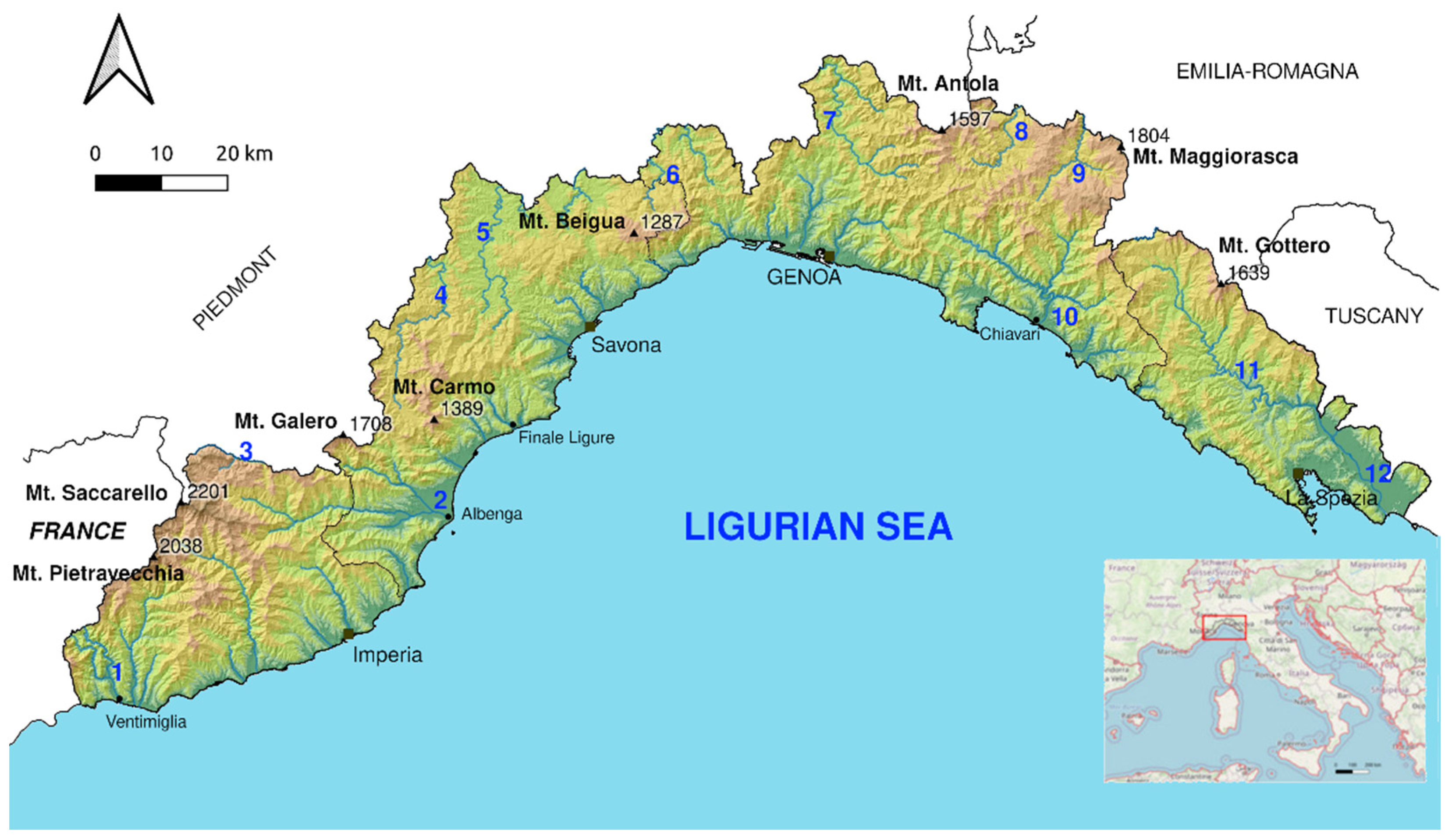

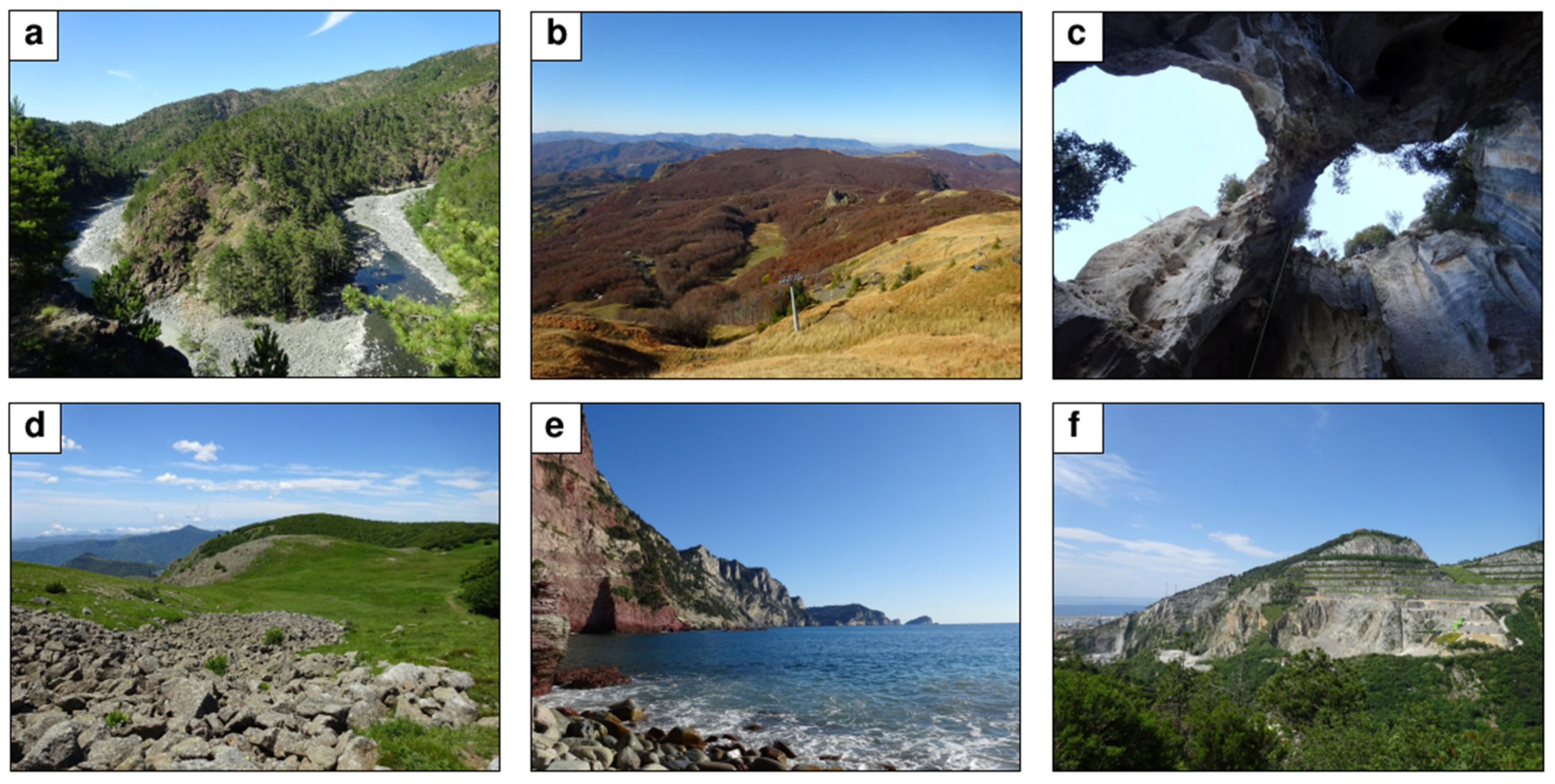
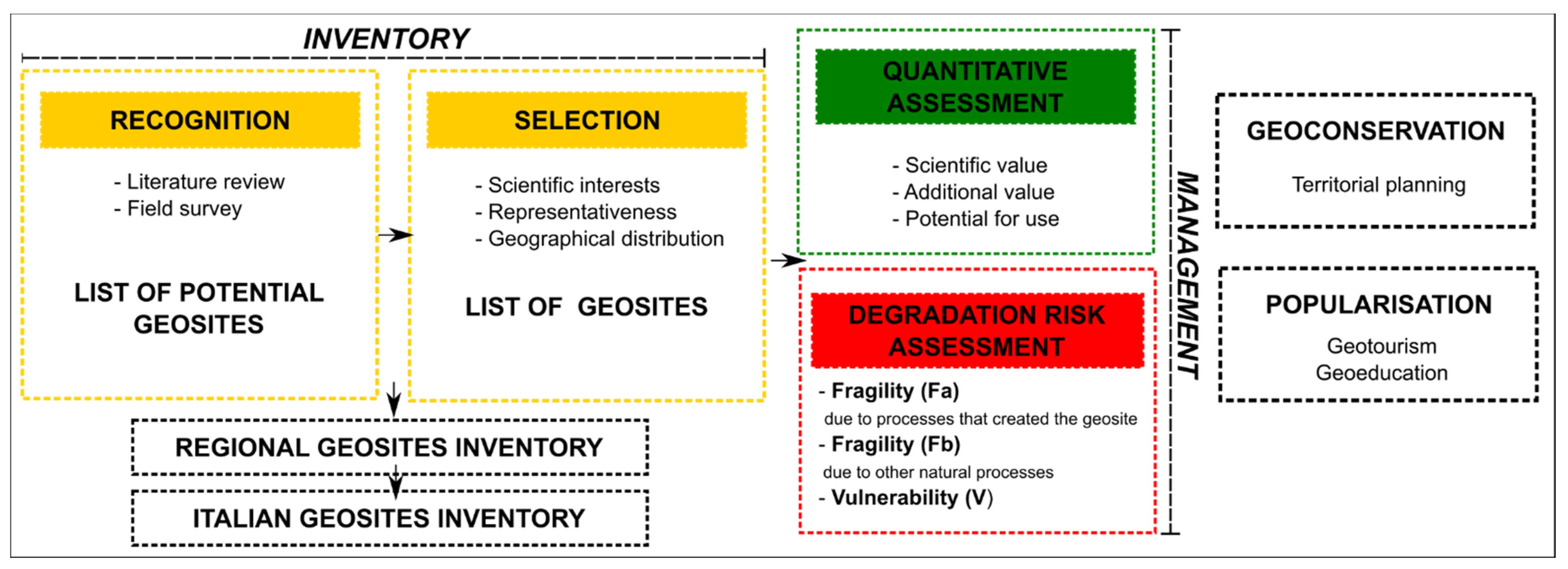


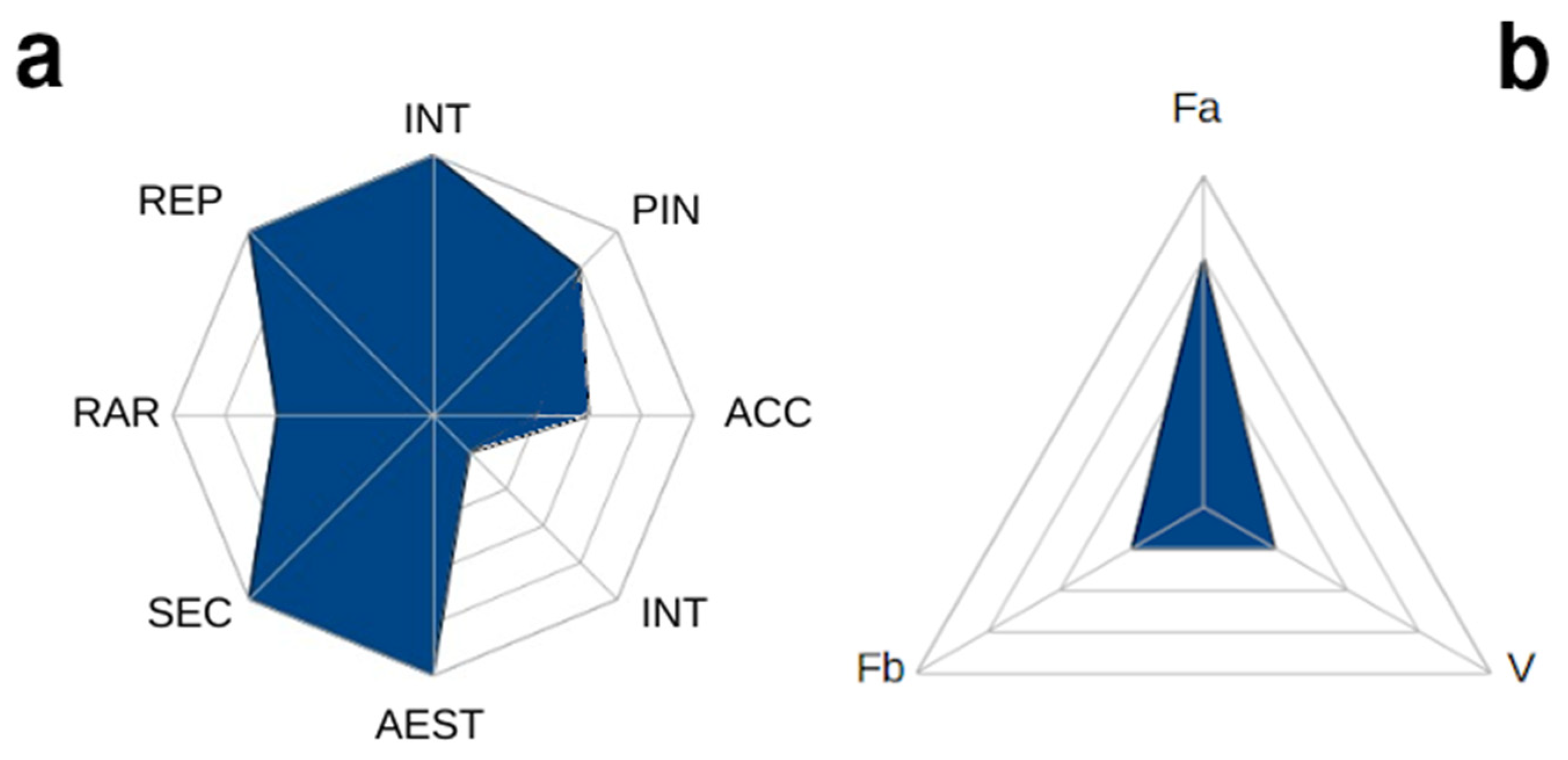
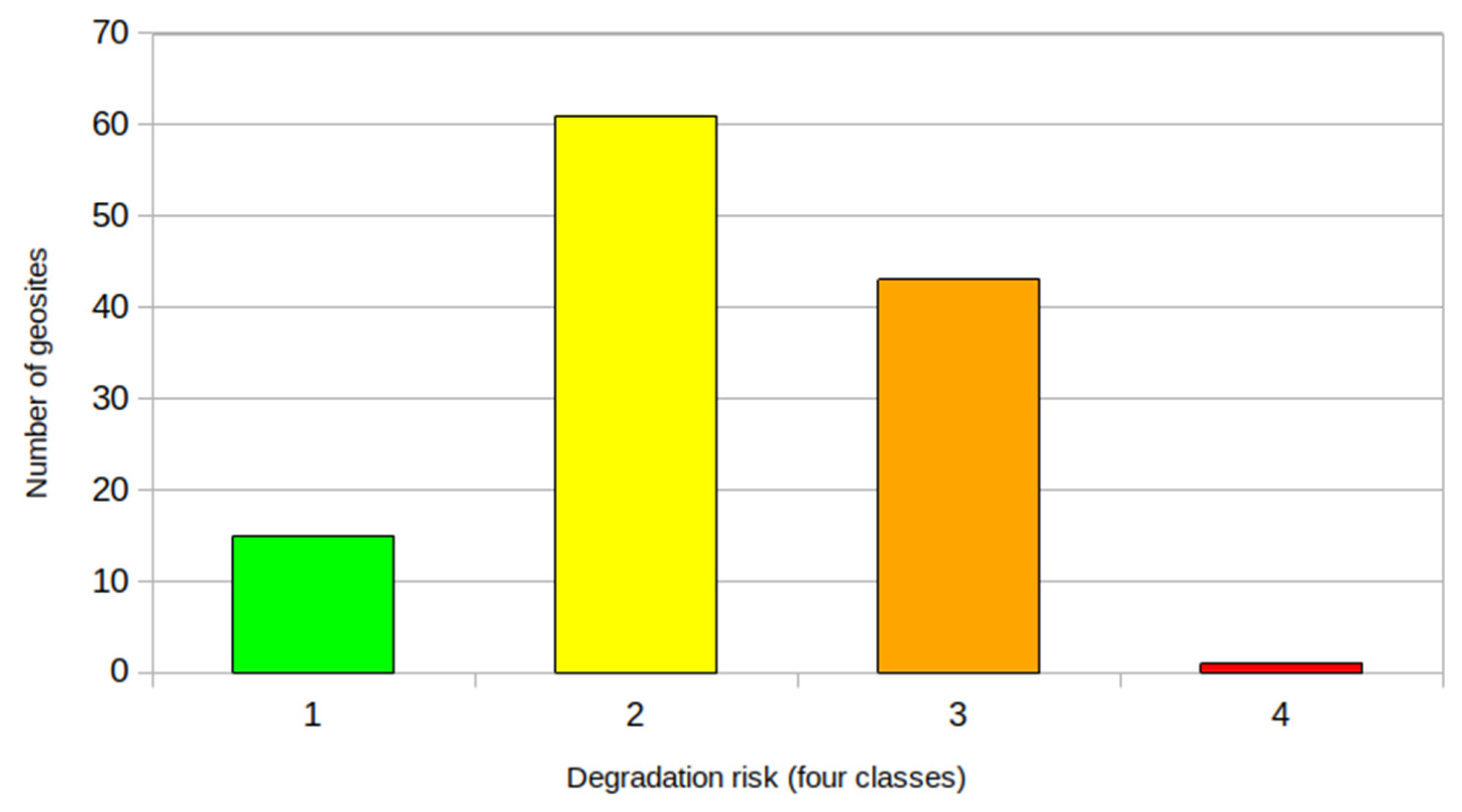

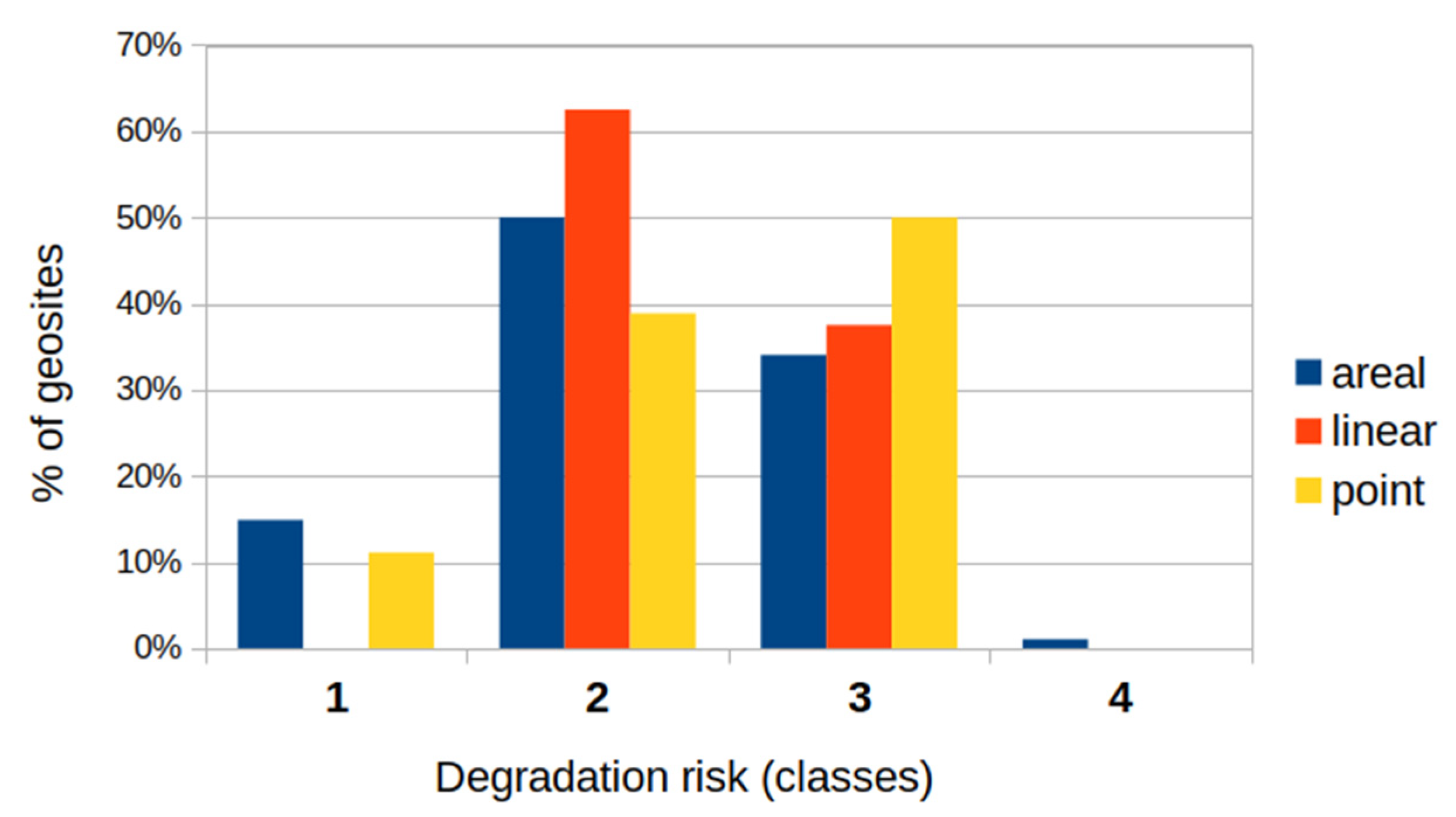
| Scientific Value | 1 | 2 | 3 | 4 | 5 |
|---|---|---|---|---|---|
| Integrity (INT) | Poor conservation | Partial damage, integrity not preserved | Partial damage, preserved integrity | Good conservation | Very good conservation |
| Representativeness (REP) | No exemplarity | Poor example of process or landform | Fair example of process or landform | Good example of process or landform | Reference site in literature for the process or landform |
| Rareness (RAR) | Very common | Rare at a local scale | Rare at a regional scale | Rare at a national scale | Rare at an international scale |
| Secondary interests (SEC) | No secondary interests | One secondary interest of poor relevance | One or more secondary interests of fair relevance | One or more secondary interests of good relevance | One or more secondary interests of great relevance |
| Additional Value | 1 | 2 | 3 | 4 | 5 | |
|---|---|---|---|---|---|---|
| Esthetic value (EST) | Naturalness | Completely modified by human action | Strongly affected by human action, some natural features are still preserved | Moderately affected by human action | Slightly affected by human action | No trace of human action |
| Panoramic quality | Site not visible from any viewpoint | Site visible from one viewpoint | Site visible from more than one viewpoint | Site visible at 360° within a close distance | Site visible from many viewpoints also from a great distance | |
| Color diversity | No color diversity | Low color diversity | Moderate color diversity | High color diversity | Very high color diversity | |
| Vertical development | Same level as the surrounding ground | Slightly emerging from the surrounding ground | Moderately emerging from the surrounding ground | Significantly emerging from the surrounding ground | Imposing feature on the landscape | |
| Cultural value (CULT) | Historical importance | No historical importance | Historical importance, no connection to geological and geomorphological features | Historical importance with connection to geological or geomorphological features of the site | Local historical importance with connection to both geological and geomorphological features of the site | National historical importance with connection to both geological and geomorphological features of the site |
| Archaeological importance | No archaeological importance | Archaeological importance, no connection to geological and geomorphological features | Archaeological importance with connection to geological or geomorphological features of the site | Local archaeological importance with connection to both geological and geomorphological features of the site | National archaeological importance with connection to both geological and geomorphological features of the site |
| Potential for Use | 1 | 2 | 3 | 4 | 5 |
|---|---|---|---|---|---|
| Accessibility (ACC) | Accessible only by experts with specific technical skills (e.g., climbers, speleologists) | Accessible by experts, but no specific technical skills are required | Accessible by people in good physical form | Accessible by people with normal movement capacity | Accessible by people with limited movement capacity |
| Interpretative potential (PIN) | Very poor: understandable only by insiders | Poor | Fair | Good | Very good: understandable by anyone |
| Scientific Value | 1 | 2 | 3 | 4 |
|---|---|---|---|---|
| Fragility due to processes that created the geosite (Fa) | Low | Medium | Moderate | High |
| Fragility due to other natural processes (Fb) | Low | Medium | Moderate | High |
| Vulnerability (V) | Low | Medium | Moderate | High |
Publisher’s Note: MDPI stays neutral with regard to jurisdictional claims in published maps and institutional affiliations. |
© 2021 by the authors. Licensee MDPI, Basel, Switzerland. This article is an open access article distributed under the terms and conditions of the Creative Commons Attribution (CC BY) license (http://creativecommons.org/licenses/by/4.0/).
Share and Cite
Ferrando, A.; Faccini, F.; Poggi, F.; Coratza, P. Geosites Inventory in Liguria Region (Northern Italy): A Tool for Regional Geoconservation and Environmental Management. Sustainability 2021, 13, 2346. https://doi.org/10.3390/su13042346
Ferrando A, Faccini F, Poggi F, Coratza P. Geosites Inventory in Liguria Region (Northern Italy): A Tool for Regional Geoconservation and Environmental Management. Sustainability. 2021; 13(4):2346. https://doi.org/10.3390/su13042346
Chicago/Turabian StyleFerrando, Andrea, Francesco Faccini, Flavio Poggi, and Paola Coratza. 2021. "Geosites Inventory in Liguria Region (Northern Italy): A Tool for Regional Geoconservation and Environmental Management" Sustainability 13, no. 4: 2346. https://doi.org/10.3390/su13042346
APA StyleFerrando, A., Faccini, F., Poggi, F., & Coratza, P. (2021). Geosites Inventory in Liguria Region (Northern Italy): A Tool for Regional Geoconservation and Environmental Management. Sustainability, 13(4), 2346. https://doi.org/10.3390/su13042346








